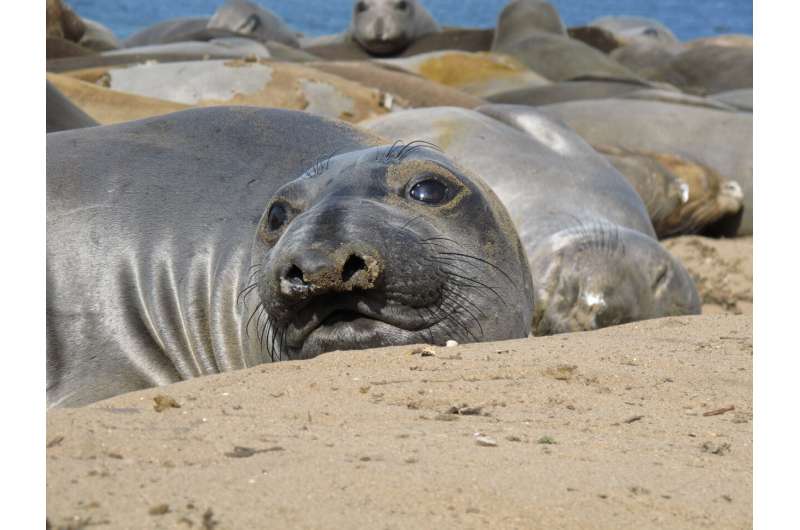Elephant seal diving mystery solved: 24-hour feeding could be a climate change sentinel

Female elephant seals weigh 350 kg on average, and dive continuously to the ocean's mesopelagic zone, about 200 to 1,000 meters deep, to consume their only prey: Small fish that weigh less than 10 grams. Now, an international team of researchers, armed with eight years' worth of data, may have answered a decades-long question: How do seals maintain their large size on such small prey?
They published their answer on May 12 in Science Advances.
"It is not easy to get fat," said paper author Taiki Adachi, research fellow with the National Institute of Polar Research and the School of Biology, University of St. Andrews. "Elephant seals have to spend almost the whole day—20 to 24 hours every day—deep diving to feed on many small fish and gain body fat stores, which is essential for successful reproduction."
The researchers outfitted 48 female elephant seals with data loggers that tracked everything from location and depth to jaw motion and seal buoyancy, which helps estimate the rate of fat gain. The loggers also used video to capture prey type. They tracked the seals during their two-month post-breeding short migrations in the Northeast Pacific Ocean between 2011 and 2018.
"We focused on this time after breeding because gaining fat energy stores is critical in their annual life cycles to determine whether they will pup again in the next breeding year, ultimately affecting population dynamics," Adachi said.
With more than five million feeding events recorded, the researchers found that on average, a single seal dove 80 to 100% of the day—that's about 60 dives a day—to eat anywhere from 1,000 to 2,000 fish and gain more calories than they burned.
"We suggest that female elephant seals, which are not capable of echolocation or filter-feeding like other large marine mammals, found a unique evolutionary pathway to enhance diving abilities relative to their body mass, allowing them to dive continuously to the mesopelagic depths and maximize feeding opportunities on abundant small fishes," Adachi said. "These results demonstrate the close relationships between body size, prey availability and hunting capacity that shape the foraging guilds within marine animals."
While the elephant seals adapted to a unique foraging niche, according to Adachi, the adaptation may also put the elephant seals at risk as ocean temperatures rise and potentially reduce prey availability.
"We suggest that the narrow behavioral niche of elephant seals severely constrains their plasticity to buffer changes in mesopelagic fish biomass," Adachi said. "The round-the-clock foraging suggests that elephant seals are vulnerable to reduction in prey abundance." The researchers plan to continue studying elephant seals' foraging activity and monitoring their fat gain rate as an indicator of prey abundance changes.
"The next step is studying elephant seals as an important living sentinel to reveal climate change effect on deep ocean ecosystems," Adachi said.
Co-authors include Akinori Takahashi and Yasuhiko Naito, National Institute of Polar Research; Daniel P. Costa, Patrick W. Robinson, Sarah H. Peterson, Rachel R. Holser and Roxanne S. Beltran, Department of Ecology and Evolutionary Biology, University of California Santa Cruz; Luis A. Hückstädt, Institute of Marine Sciences, University of California Santa Cruz; and Theresa R. Keates, Department of Ocean Sciences, University of California Santa Cruz. Costa and Peterson are also affiliated with the Institute of Marine Sciences, University of California Santa Cruz. Hückstädt is also affiliated with the Department of Biology and Marine Biology, University of North Carolina Wilmington.
More information: Taiki Adachi et al, Forced into an ecological corner: Round-the-clock deep foraging on small prey by elephant seals, Science Advances (2021). DOI: 10.1126/sciadv.abg3628
Journal information: Science Advances
Provided by Research Organization of Information and Systems





















